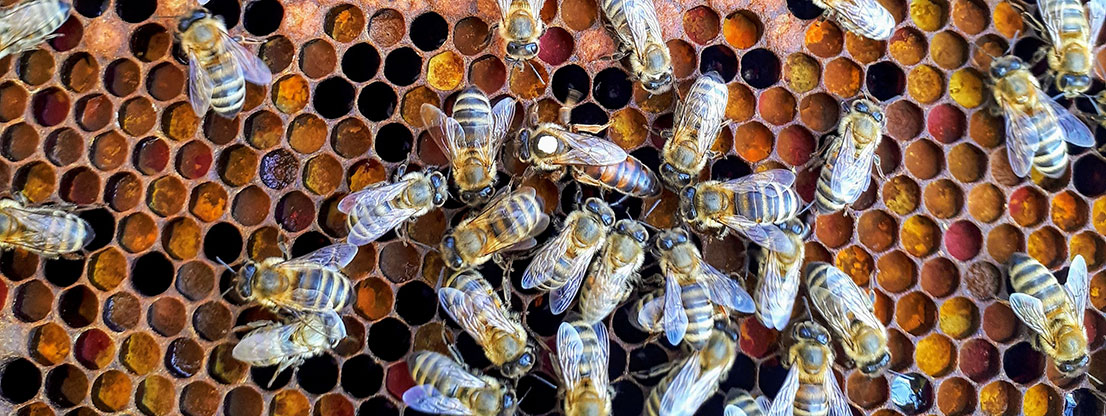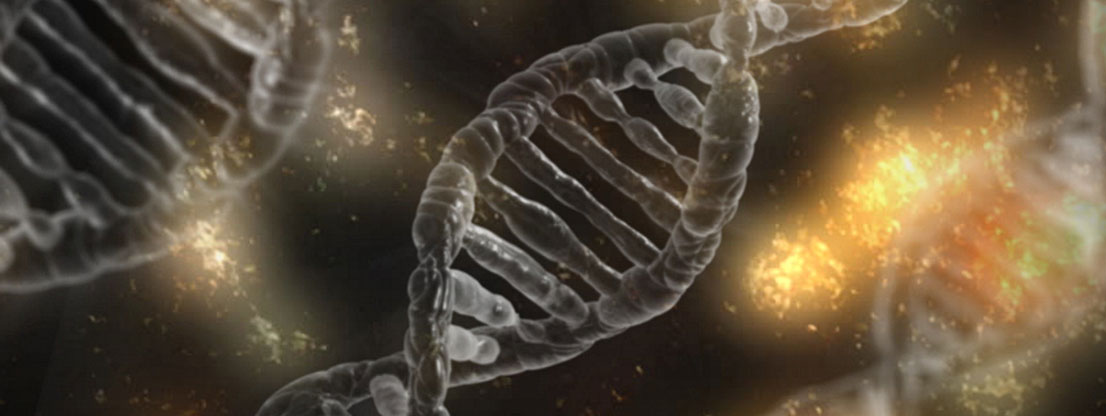In our genes it is written how we look like, how we age and which hereditary ailments and diseases we suffer from. No matter whether we have our nose shrunk or lose a leg in an accident: If we are changed by external influences, we cannot pass on any of these characteristics to our children.
At least that was the assessment of science for a long time. Only recent research has shown that our environment does indeed have an influence on our development, including at the genetic level. And that we can even pass on traits gained in this way to our children and grandchildren. But how is this supposed to work? Is the old evolutionary principle, known since Darwin, of evolution from random changes and subsequent environmental sorting out of bad traits simply thrown overboard? Of course not. But the issue of our genes is even more complex than long assumed. Let us take a look at some practical examples.
You are what you eat – succession in the bee colony

A bee colony consists of a queen and many workers. The queen lays eggs from which larvae hatch, which usually become workers. The worker bees are all genetically identical to each other, i.e. they have the same genetic information. In order for the colony to survive, however, a new queen bee has to grow at regular intervals. The scientists were astonished to find that the growing queen bee had the same genetic information as the worker bees, although she was fundamentally different from the other bees both in her physique and behaviour. This means that only external influences can be held responsible for the queen’s characteristics. The key was found in the food given to the larvae that would later become queens. A worker larva is fed royal jelly, a secretion produced in the bees’ pharyngeal glands, for the first three days. After that, however, it is fed pollen and nectar. A future queen bee, on the other hand, is fed her entire larval period with royal jelly, which leads to a completely different development. An external factor therefore plays a decisive role in the later appearance and function of a bee larva in the hive. [1]
Inheritance of acquired characteristics? – Epigenetics in the Swedish community of Överkalix
Överkalix is a small and relatively isolated municipality in Sweden. Compared to other municipalities, the population of Överkalix remained largely isolated and all the inhabitants were exposed to similar environmental influences locally. The people of Överkalix had also kept detailed records of important data on harvests or births over a long period of time, which enabled scientists to trace the lives of several generations of inhabitants and the influences to which they were exposed during their lives. The researchers found that the children of women who suffered from hunger during their pregnancy had more cardiovascular problems. Even more interesting, though, was the observation that these cardiovascular problems were also found in their grandchildren, but only in the female offspring. And this was not the only observed phenomenon. For example, boys who started smoking at an early age in their youth produced offspring with a higher average body mass index (BMI), the value that indicates body weight in relation to height. However, the effect was only found in male offspring. If a boy grew up under food overabundance, his sons and grandsons had a shorter life span. No change was found in women. [2][3]

What does epigenetics signify for our way of life?
The example of Överkalix shows us that our way of life does have an influence on our genetics and that we can even pass on various traits to our descendants. Although epigenetics is still a relatively unexplored field of research, a healthy lifestyle in which emphasis is placed on factors such as a healthy diet, sufficient exercise and little stress certainly has a positive effect on us, but also on our descendants, even if these effects may not be obvious at first glance. Negative influences, on the other hand, can also have negative effects. A mindful and healthy lifestyle can therefore bring about many positive effects in terms of health.
The roots lie in the DNA
To understand how the mechanisms of epigenetics work, we need to move to the molecular level and look at our genetic information and the processes behind it. In the middle of the 20th century, DNA or deoxyribonucleic acid was discovered, the site of our genetic information that determines our appearance and all processes in our body. Genes are sections of the DNA that are important for the characteristics of an organism.
The majority of our DNA is present in the chromosomes in the cell nucleus, packed in two long antiparallel strands, the so-called double helix. It consists of countless building blocks strung together, each of which pairs with a specific other building block. There are four building blocks: Adenine and thymine and cytosine and guanine. In total, a single strand of human DNA consists of about 3 billion of these base pairs. The gene segments on the DNA are read and translated into proteins by a complicated mechanism called translation. Proteins are the basic building blocks of all life. However, many base sequences in DNA are never read, but are silenced by certain mechanisms. The reading pattern of the genes, it seemed, is predetermined when a new human being is created and cannot be changed. At least that is what science assumed for a long time. But this is precisely where the new findings in epigenetics are situated.
The mechanism of epigenetics

Changes in DNA – How is this possible?
The sequence of the base pairs does not change. Instead, the processes of epigenetics deal with the question of whether, and if so how often, certain parts of the DNA are read. In animals, DNA is packed into chromosomes inherited from both father and mother. In total, humans have 23 pairs of chromosomes, including one sex chromosome pair. The sex chromosome pair is XX in women and XY in men. Often genes are located on only one of the two sex chromosomes. It can happen, for example, that genetic information is only read off the Y chromosome and suppressed on the X chromosome, which can be seen in the gender-specific inheritance of characteristics using the example of Överkalix. Our life circumstances have an influence on which genes are read and which are not. There are several mechanisms for this selective reading. These include DNA methylation and histone modification.
DNA Methylation
In methylation, DNA is chemically modified by the enzyme DNA methyltransferase and marked by the addition of a methyl group. Such a marker influences whether certain regulatory proteins can bind at this site and thus whether the DNA can be read or not. This mechanism can be seen in mice, for example. If a certain gene sequence of the so-called agouti gene is methylated, this gene is suppressed and brown mice are born. However, if this part of the gene is not methylated, the agouti gene can be read and white mice are born. By means of certain regulatory mechanisms, the so-called “maintenance methylases”, methylated sites can be recognised and maintained when the genetic information is duplicated, i.e. also when it is passed on to offspring. These maintenance methylases can, in turn, be suppressed or inactivated by other mechanisms, thus enabling further control. [4]
Histone modification
Histone modifications are another mechanism of epigenetics. The long chain of DNA bases is wrapped at regular intervals around protein nuclei consisting of so-called histones. These histone nuclei are connected to other histone nuclei. External influences can influence how closely packed the histones wrapped with DNA are. If they are very close together, reading and copying complexes cannot bind to the DNA. If, on the other hand, they are far apart, reading and conversion into proteins is no problem. The packing density of the DNA can therefore be regulated by external influences to determine which genes are used to produce proteins and which genes are silenced. There are also many regulation mechanisms for the packaging density, which decide whether the packaging density is changed or maintained during cell division and inheritance. [5]
Scientific sources
[1] Biologie Seite: Bienenkönigin, Online.
[2] Marcus Pembrey: Male-line transgenerational responses in humans, 2010, Online.
[3] Emma Marczylo / Akwasi Amoako et al. Smoking induces differential miRNA expression in human spermatozoa: A potential transgenerational epigenetic concern?, 2011, Online.
[4] [5] James Watson/ Tania Baker/ Stephen Bell / Alexander Gann / Michael Levine : Molekulare Biologie, 2010




